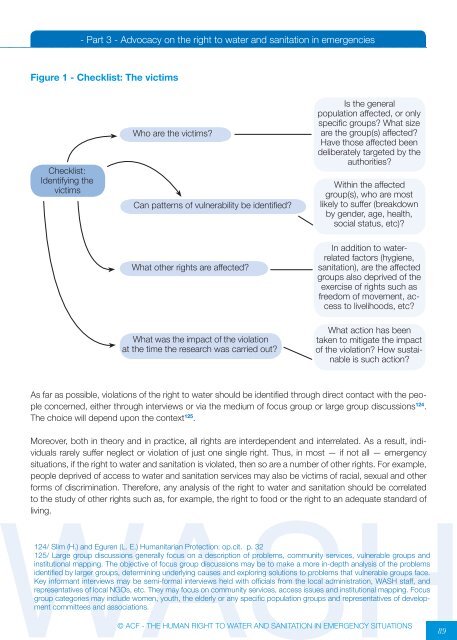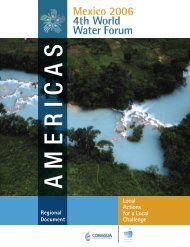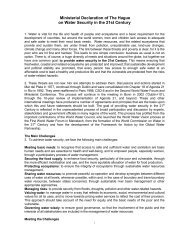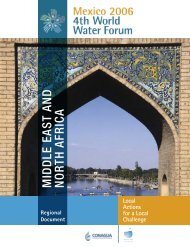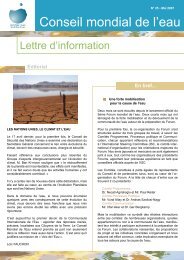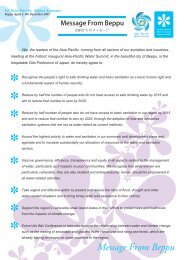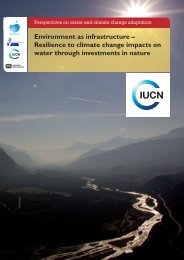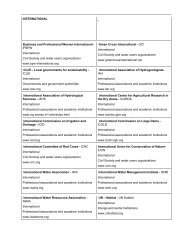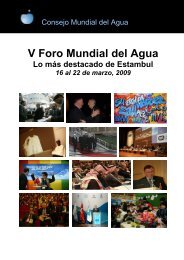the human right to water and sanitation in emergency situations
the human right to water and sanitation in emergency situations
the human right to water and sanitation in emergency situations
Create successful ePaper yourself
Turn your PDF publications into a flip-book with our unique Google optimized e-Paper software.
Figure 1 - Checklist: The victims<br />
Checklist:<br />
Identify<strong>in</strong>g <strong>the</strong><br />
victims<br />
- Part 3 - Advocacy on <strong>the</strong> <strong>right</strong> <strong>to</strong> <strong>water</strong> <strong>and</strong> <strong>sanitation</strong> <strong>in</strong> emergencies<br />
Who are <strong>the</strong> victims?<br />
Can patterns of vulnerability be identified?<br />
What o<strong>the</strong>r <strong>right</strong>s are affected?<br />
What was <strong>the</strong> impact of <strong>the</strong> violation<br />
at <strong>the</strong> time <strong>the</strong> research was carried out?<br />
Is <strong>the</strong> general<br />
population affected, or only<br />
specific groups? What size<br />
are <strong>the</strong> group(s) affected?<br />
Have those affected been<br />
deliberately targeted by <strong>the</strong><br />
authorities?<br />
With<strong>in</strong> <strong>the</strong> affected<br />
group(s), who are most<br />
likely <strong>to</strong> suffer (breakdown<br />
by gender, age, health,<br />
social status, etc)?<br />
In addition <strong>to</strong> <strong>water</strong>related<br />
fac<strong>to</strong>rs (hygiene,<br />
<strong>sanitation</strong>), are <strong>the</strong> affected<br />
groups also deprived of <strong>the</strong><br />
exercise of <strong>right</strong>s such as<br />
freedom of movement, access<br />
<strong>to</strong> livelihoods, etc?<br />
What action has been<br />
taken <strong>to</strong> mitigate <strong>the</strong> impact<br />
of <strong>the</strong> violation? How susta<strong>in</strong>able<br />
is such action?<br />
As far as possible, violations of <strong>the</strong> <strong>right</strong> <strong>to</strong> <strong>water</strong> should be identified through direct contact with <strong>the</strong> people<br />
concerned, ei<strong>the</strong>r through <strong>in</strong>terviews or via <strong>the</strong> medium of focus group or large group discussions 124 .<br />
The choice will depend upon <strong>the</strong> context 125 .<br />
Moreover, both <strong>in</strong> <strong>the</strong>ory <strong>and</strong> <strong>in</strong> practice, all <strong>right</strong>s are <strong>in</strong>terdependent <strong>and</strong> <strong>in</strong>terrelated. As a result, <strong>in</strong>dividuals<br />
rarely suffer neglect or violation of just one s<strong>in</strong>gle <strong>right</strong>. Thus, <strong>in</strong> most — if not all — <strong>emergency</strong><br />
<strong>situations</strong>, if <strong>the</strong> <strong>right</strong> <strong>to</strong> <strong>water</strong> <strong>and</strong> <strong>sanitation</strong> is violated, <strong>the</strong>n so are a number of o<strong>the</strong>r <strong>right</strong>s. For example,<br />
people deprived of access <strong>to</strong> <strong>water</strong> <strong>and</strong> <strong>sanitation</strong> services may also be victims of racial, sexual <strong>and</strong> o<strong>the</strong>r<br />
forms of discrim<strong>in</strong>ation. Therefore, any analysis of <strong>the</strong> <strong>right</strong> <strong>to</strong> <strong>water</strong> <strong>and</strong> <strong>sanitation</strong> should be correlated<br />
<strong>to</strong> <strong>the</strong> study of o<strong>the</strong>r <strong>right</strong>s such as, for example, <strong>the</strong> <strong>right</strong> <strong>to</strong> food or <strong>the</strong> <strong>right</strong> <strong>to</strong> an adequate st<strong>and</strong>ard of<br />
liv<strong>in</strong>g.<br />
124/ Slim (H.) <strong>and</strong> Eguren (L. E.) Humanitarian Protection: op.cit. p. 32<br />
125/ Large group discussions generally focus on a description of problems, community services, vulnerable groups <strong>and</strong><br />
<strong>in</strong>stitutional mapp<strong>in</strong>g. The objective of focus group discussions may be <strong>to</strong> make a more <strong>in</strong>-depth analysis of <strong>the</strong> problems<br />
identified by larger groups, determ<strong>in</strong><strong>in</strong>g underly<strong>in</strong>g causes <strong>and</strong> explor<strong>in</strong>g solutions <strong>to</strong> problems that vulnerable groups face.<br />
Key <strong>in</strong>formant <strong>in</strong>terviews may be semi-formal <strong>in</strong>terviews held with officials from <strong>the</strong> local adm<strong>in</strong>istration, WASH staff, <strong>and</strong><br />
representatives of local NGOs, etc. They may focus on community services, access issues <strong>and</strong> <strong>in</strong>stitutional mapp<strong>in</strong>g. Focus<br />
group categories may <strong>in</strong>clude women, youth, <strong>the</strong> elderly or any specific population groups <strong>and</strong> representatives of development<br />
committees <strong>and</strong> associations.<br />
© ACF - THE HUMAN RIGHT TO WATER AND SANITATION IN EMERGENCY SITUATIONS<br />
89


